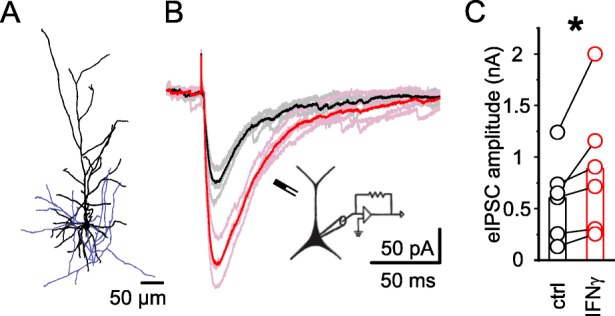Fig. 4.

IFN-γ increases the amplitude of evoked IPSCs in neocortical layer 5 pyramidal neurons. Electrically evoked IPSCs were recorded in the presence of CNQX and DAP5 to block ionotropic glutamate receptors. a Exemplary layer 5 pyramidal neuron stained with biocytin and reconstructed to ensure neuronal identity when electrophysiological characterization was impaired by recording conditions. Soma and dendrites are represented in black, the axon in blue. b Example traces of IPSCs evoked before (gray) and after 30 min of IFNγ application (1000 IU ml−1; rose). Averaged traces are shown in black (before IFN-γ application) and red (after IFN-γ application). A scheme of the experimental setup, including the apicolaterally positioned bipolar stimulation electrode, is depicted below. c Maximum amplitudes of all eIPSCs increased under the influence of IFN-γ. Analysis of eIPSC amplitudes was performed before and 20 to 40 min after the application of IFN-γ. Holding current (507.9 ± 189.0 pA vs. 1285.9 ± 626.0 pA, n = 6; P = 0.22, Wilcoxon signed-rank test) and Rs (Rs-ctrl = 9.2 ± 2.1 MΩ vs. Rs-IFN-γ = 9.4 ± 2.2 MΩ, n = 6; P = 0.7, Wilcoxon signed-rank test) remained comparable. Average rat age P23.7 ± 0.8
